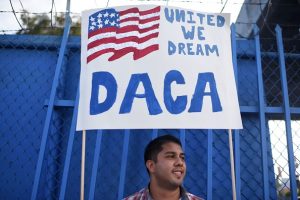
(Photo credit: Robyn Beck/AFP/Getty Images)
Last week, the Supreme Court narrowly agreed not to rescind the DACA program, thus permitting young undocumented immigrants to remain in the United States for at least the near future.
What it didn’t do was rule on the wisdom of DACA or say that the Trump administration cannot lawfully rescind it.
Some background — the Deferred Action for Childhood Arrivals (DACA) program was created in 2012 by President Barack Obama to side-step years of Congressional logjam on immigration reform. It happened through an executive memorandum ordering the Department of Homeland Security to defer the immigration prosecution of certain young people who entered the country without papers. To qualify, the young people had to have lived here since 2007, had to either be students or completed high school, or had to be honorably discharged from the military.
They also had to have committed no serious crimes, not posed a threat to national security or public safety, and be under the age of 31. In 2014, this program was expanded to include people of any age who entered the United States before the age of 16 and lived in the U.S. continuously since 2010. The 2014 changes also attempted to defer the prosecution of parents of U.S.-born children (called DAPA), but this initiative was stillborn when it drew immediate court challenge and was ruled illegal.
The interesting thing about DACA is that all litigants in the recent Supreme Court argument agree that it was unlawfully established. As Justice Clarence Thomas said in his dissent, it was a program created “unilaterally through a mere memorandum,” while it should have been either a legislative decision or drawn up through the normal rule-making process. “To state it plainly,” Thomas wrote, “the Trump administration rescinded DACA the same way that the Obama administration created it,” and according to him, there’s nothing illegal about that.
So why did five justices agree to let DACA survive, if even just for the moment? Their rationale, written by Chief Justice John Roberts (considered to be in the conservative camp), was that it wouldn’t be fair to renege on a promise made by the government, upon which so many relied.
Putting into immediate deportation the over 7,000 young immigrants who have “enrolled in degree programs, embarked on careers, started businesses, bought homes, gotten married and had children,” would be unjust, Roberts said.
He also cited the economic impact rescinding DACA would have. The cost of replacing workers would total $6.3 billion. There’d be a $25 billion loss in economic activity, a $60 billion loss in federal tax revenue over 10 years, and $1.25 billion loss in state and local tax revenue.
The DACA feud got started when the Trump administration wrote its own memorandum rescinding the Obama administration’s memorandum. The thought was, if Obama could create DACA with a mere memorandum, then Trump could rescind it with one.
The majority opinion, however, faulted this logic, saying that for any action to be in compliance with the Administrative Procedure Act (which governs decisions taken by the Department of Homeland Security), it must not be “arbitrary or capricious.” The fact that the Trump memo failed to consider the “reliance interests” of DACA recipients made the decision to rescind “arbitrary and capricious.”
While pro-DACA litigants included an equal protection argument stating that Trump’s overt hostility toward immigrants, who he’s called “criminals, drug dealer and rapists,” was an overt violation of equal protection law, the majority didn’t find this claim substantiated because Trump’s prior statements were not “contemporary” with the memo. (Justice Sonia Sotomayor was the only judge who would have upheld the equal protection claim.)
The decision is viewed by all sides as political. As President Donald Trump tweeted: “These horrible & politically charged decisions coming out of the Supreme Court are shotgun blasts into the face of people that are proud to call themselves Republicans or Conservatives. We need more Justices or we will lose our 2nd. Amendment & everything else. Vote Trump 2020!”
The justices have given the Trump administration a roadmap for a second go at getting DACA rescinded. According to the decision, his administration just has to “assess the existence and strengths of any reliance interests and weigh them against competing police concerns” in order to pass muster.
But this might not be so easy. This weighing of interests should take time, at least if it’s to be done right.
Hopefully, the time it takes will be enough for U.S. voters to decide who they want in office when and if the DACA fight is revisited.
Toni Messina has tried over 100 cases and has been practicing criminal law and immigration since 1990. You can follow her on Twitter: @tonitamess.

